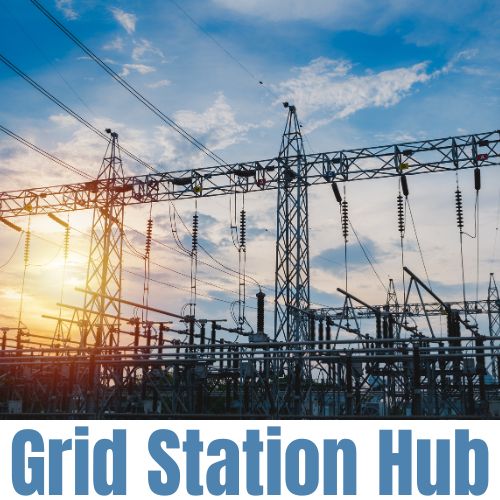A lightning arrester, also known as a surge arrester or surge protector, is an important component in electrical systems, particularly in substations. The lightning arresters' primary purpose is to protect the Substation's electrical equipment from the harmful effects of lightning and voltage surges. This comprehensive article explores the function of lightning arresters in substations, working principles, their role in transformers, earthing considerations, advantages and disadvantages.
Function of Surge Arresters in Substations:
Lightning arresters play an important role in the protection of power systems by safely diverting excessive lightning or surge currents to ground. They prevent damage to substation equipment, transmission lines, and transformers from lightning strikes or voltage surges. The primary function of a lightning arrester is to provide a low-impedance path for the discharge of high-energy transient currents, leading them away from sensitive equipment.
Principle of operation of lightning arresters:
Surge arresters work on the principle of voltage clamping. They are designed with a gap composed of non-linear resistive materials, such as metal oxide varistors (MOVs) or silicon carbide (SiC). During normal operation, the arrester remains non-conductive. However, when a high voltage surge occurs, the resistive material becomes conductive, effectively blocking the voltage to a safe level and diverting the surge current through ground to ground.
Lightning Arresters in Transformers:
Transformers are critical power system components that are sensitive to lightning strikes and surges. Lightning arresters attached to transformers act as the first line of defense by blocking any high voltage surges that could potentially damage the transformer winding and insulation. The lightning arrester provides a low-resistance path to ground for the surge, diverting it from the transformer.
Lightning Arrester Earthing:
Proper earthing of lightning arresters is essential for their efficient operation. An arrester must have a low-resistance path to ground to effectively dissipate lightning surges. This includes establishing a robust grounding system that complies with relevant standards and ensures electrical safety.
Lightning Earthing System:
An electrical earthing system consists of a network of grounding electrodes and conductors designed to provide a path of low impedance for electrical currents. System effectiveness depends on proper design, installation and maintenance of grounding electrodes, conductors and connections. Lightning arrester earthing forms an integral part of this system to ensure safe dissipation of power surges.
Advantages of lightning Arresters:
- a) Surge Protection: Lightning arresters provide strong protection against lightning and high voltage surges, preventing damage to equipment and reducing downtime.
- b) Longevity of equipment: By removing harmful surges from sensitive equipment, lightning arresters help extend the life of substations and electrical equipment.
- c) Safety: Lightning arresters improve safety by preventing electrical fires, equipment failures, and electrical hazards caused by lightning strikes or surges.
- d) Cost-effective: Investing in lightning arresters can save substations significant costs associated with equipment repair, replacement, and downtime resulting from lightning damage.
Disadvantages of lightning Arresters:
- a) Maintenance: Lightning arresters require periodic inspection and maintenance to ensure their effectiveness. This increases the overall maintenance costs of the substations.
- b) Limited Life: Lightning arresters have a limited life and may need to be replaced after a certain number of surge events or years of service.
- c) Improper tripping: In rare cases, lightning arresters may be triggered incorrectly due to transient voltages or surges, causing unnecessary power interruptions.
Conclusion:
Lightning arresters play an important role in protecting substations and electrical equipment from lightning surges. By safely diverting high-energy transients to ground, lightning arresters prevent damage, improve system reliability, and enhance electrical safety. Despite their maintenance requirements and limited lifespan, the advantages of arresters far outweigh the disadvantages, making them an essential component of modern substation design.
FAQ
Q1- What is the definition and function of lightning arrester?
Definition: A lightning arrester, also known as a surge arrester or surge protector, is a protective device used in electrical systems to divert excessive electrical currents caused by lightning strikes or voltage surges to the ground.
Function: The primary function of a lightning arrester is to protect electrical equipment and systems from damage by providing a low-resistance path for high-energy surges. It intercepts and redirects lightning or surge currents away from sensitive equipment, preventing their harmful effects such as equipment failure, fires, or electrical hazards.
Q2- Where is the lightning arrester installed in grid station?
The lightning arrester are installed at various key locations within a grid station, including at the entrance of the station, on transmission lines, both the HV and LV sides of the transformer
Q3- Which lightning arrester are mostly used in a Grid station?
In grid stations, the most commonly used lightning arrester is the metal oxide varistor (MOV) type. MOV lightning arresters are widely preferred due to their high-energy absorption capability, compact size, fast response time, and ability to handle high-voltage surges effectively. MOV lightning arresters provide reliable protection for grid station equipment and systems against lightning strikes and voltage surges.
Q4- How do you calculate lightning arrester rating?
The lightning arrester rating is typically determined based on the maximum system voltage and the required level of protection. It is calculated by considering factors such as the insulation level of the equipment being protected, the location of the lightning arrester in the system, and the anticipated magnitude of lightning surges in the area. Engineering calculations and standards, such as IEEE or IEC, provide guidelines for selecting the appropriate lightning arrester rating based on these factors.



